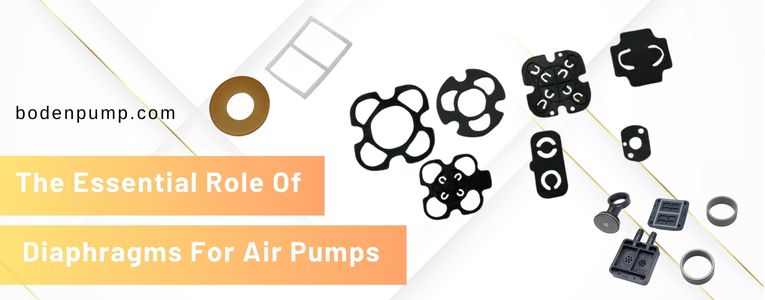
As the Project Manager at BODENFLO, focusing on micro diaphragm pumps, I have witnessed the critical role that diaphragms play in the efficiency and functionality of air pumps. Diaphragms are not just components; they are the heartbeat of air pumps, influencing everything from operational efficiency to maintenance needs. Understanding their importance can greatly enhance how these pumps are utilized in various applications.
Why are diaphragms so crucial in air pumps? Diaphragms serve as the dynamic boundary between the air and the mechanical parts, ensuring that the air is pumped efficiently and reliably without leakage. Their flexibility allows for the creation of pressure differentials essential for the pump’s operation, making them indispensable in systems requiring precise air flow control.
The function of diaphragms extends beyond simple mechanics. Their design and material composition directly impact the pump's performance, longevity, and suitability for different environments. Let's dive deeper into the essential role of diaphragms for air pumps and how they shape the capabilities of these vital devices.
Why Use Diaphragms in Air Pumps?
Diaphragms play an indispensable role in the functionality of air pumps, acting as both a barrier and an actuator within the system. Their unique ability to flex, expand, and contract with each operation cycle facilitates the essential pressure differential needed for effective air transfer. This mechanical action ensures efficient air flow and eliminates the need for internal lubricants, which could compromise the purity of the air being pumped.
Essential for Maintaining Air Purity
One of the key advantages of using diaphragms in air pumps is their contribution to maintaining air purity. Unlike other pumping mechanisms that might require lubrication, diaphragms operate without contaminating the air, making them ideal for applications in medical, food processing, and semiconductor manufacturing, where cleanliness and contamination control are paramount.
Durability and Efficiency
Moreover, diaphragms are designed to be durable and long-lasting. Made from materials such as Teflon, EPDM, or silicone, they can withstand repetitive movements and harsh conditions without degrading. This resilience translates into lower maintenance costs and downtime, enhancing the overall efficiency of the air pump systems.
Material Considerations for Diaphragms
Selecting the optimal material for diaphragms in air pumps is critical to their performance and longevity. The material must be robust enough to handle the specific demands of each application, including chemical exposure, temperature fluctuations, and constant mechanical activity.
Key Material Choices
- EPDM (Ethylene Propylene Diene Monomer): Renowned for its exceptional flexibility and fatigue resistance, EPDM is ideally suited for versatile applications. It performs well under varying weather conditions, making it a popular choice in both outdoor and industrial settings.
- Teflon (PTFE): When chemical resistance is paramount, Teflon is the preferred choice. Its inert properties ensure that it does not react with aggressive substances, making it essential for applications involving corrosive chemicals.
- Silicone: Known for its excellent performance across a broad temperature range, silicone is durable and maintains its properties in both high and low-temperature environments. This makes it ideal for applications requiring sterilization or those exposed to extreme weather.
These materials are carefully chosen to ensure that diaphragms not only meet the functional requirements of air pumps but also contribute to their efficient operation over time. Each material offers unique benefits that can enhance the performance and reliability of air pump systems, making proper selection a key factor in achieving optimal outcomes.
Design and Functionality
The design of the diaphragm is a critical factor that significantly affects the efficiency and effectiveness of air pumps. A well-engineered diaphragm is central to achieving optimal performance, as it must balance flexibility and strength to function correctly.
Optimizing Diaphragm Design
- Material Thickness and Flexibility: The thickness of the diaphragm directly influences its ability to flex. An overly thick diaphragm may hinder necessary movement, while one that is too thin may not withstand the operational stresses, leading to premature failure.
- Diameter and Shape Customization: The diameter and shape of the diaphragm should be tailored to match the specific requirements of the pump. This customization ensures that the diaphragm can deliver the maximum force efficiently, enhancing the pump's overall air flow capabilities.
By meticulously designing the diaphragm with these factors in mind, manufacturers can ensure that air pumps operate at peak efficiency, providing reliable and effective performance across various applications. This detailed attention to diaphragm design is essential for the long-term success and reliability of air pumping systems.
Advantages of Using Diaphragms in Air Pumps
Diaphragm air pumps offer several unique advantages that make them particularly suitable for sensitive and critical applications across various industries.
Key Benefits of Diaphragm Air Pumps
- No Contamination: The absence of oil and other lubricants in the air chamber ensures that the air remains pure. This feature is vital for industries such as healthcare, food processing, and semiconductor manufacturing, where contamination can compromise product integrity and safety.
- Low Maintenance Requirements: With fewer moving parts and no need for oil, diaphragm air pumps require less upkeep. This reduces both downtime and maintenance costs, contributing to a higher return on investment.
- Quiet Operation: Diaphragm air pumps operate with less noise compared to other pump types, making them suitable for use in quiet environments like hospitals, laboratories, and residential areas. This silent operation helps maintain a more comfortable and less disruptive atmosphere.
These benefits highlight the practicality and efficiency of diaphragm air pumps, reinforcing their role in ensuring clean, quiet, and cost-effective air transfer in various critical applications.
Applications of Diaphragm Air Pumps
Diaphragm air pumps are integral to numerous sectors, demonstrating a broad scope of functionality that spans from medical devices to industrial and environmental systems.
Broad-Spectrum Utility
- Medical Applications: These pumps are essential in respiratory machines and pneumatic compression therapy, where reliability and cleanliness are paramount. They ensure precise air pressure and volume, crucial for patient care and therapeutic applications.
- Industrial Uses: Utilized for pneumatic controls and air sampling, diaphragm air pumps provide uncontaminated air supply, essential in processes where purity is critical.
- Environmental Contributions: In water treatment facilities, these pumps aerate water efficiently and cleanly, enhancing the treatment process without introducing impurities.
- Automotive and Aerospace: In these high-stakes industries, diaphragm pumps ensure consistent air delivery for brake systems and cabin pressure controls, adapting smoothly to varying pressures and demands.
- Environmental Systems: They are crucial in air sampling and pollution monitoring, providing the reliability needed to accurately assess and manage air quality in varying environmental conditions.
This versatility underscores the diaphragm air pump's vital role in supporting a wide array of critical functions across different industries, highlighting their importance in maintaining operational standards and improving system efficiencies.
Challenges and Considerations
While diaphragm air pumps offer numerous benefits, they also face challenges such as diaphragm wear over time, which can affect pump efficiency and the quality of air output. Regular monitoring and maintenance are recommended to ensure that they continue to operate optimally.
Conclusion
Diaphragms are the heart of air pumps, providing the necessary mechanism for efficient and clean air movement. At BODENFLO, we understand the importance of selecting the right diaphragm material and design to meet the specific needs of your applications. By leveraging advanced materials and innovative designs, we ensure that our pumps deliver unmatched performance and reliability.
For more insights into our diaphragm pump technologies or to discuss your specific needs, visit our website or contact our expert team. Let’s enhance your operations with high-quality, precision-engineered pump solutions tailored to your requirements.


